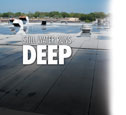Built in 1977, the Oklahoma Gas & Electric Company's (OG&E's) Muskogee power plant provides electricity to Oklahoma's northeast corner. Performing reroofing work on such a facility carries a tremendous responsibility—any electrical service disruption could have potentially devastating effects for the community. And working in such close proximity to boilers presents a substantial safety risk to workers.
OG&E and the project's roof consultant, Amtech Building Sciences, Richardson, Texas, selected Empire Roofing Ltd., Fort Worth, Texas, to face the grueling task of reroofing boiler rooms No. 4 and 5.
Not for the weak
The roof is located on the 11th floor of a 20-story structure containing coal-fired boilers used to power steam turbines generating electricity. Nine levels of boiler structures are above the 11th floor, and no intermediate floors exist below. The deck and roof system were collapsing from the weight and extreme degradation they experienced, and roofing materials were falling 150 feet to the internal parts of the boiler machinery. The potential disaster from falling debris could interrupt or prohibit boiler operations, resulting in a power outage for Oklahoma residents.
Directly below the corroded and failing deck were the boilers, which generate a constant, humid 160 F wind updraft. The unforgiving heat and wind made work especially difficult for the crews of 10-12 workers. Abbreviated shifts were created to allow workers respite from the heat.
The structure is enormously complex with many tripping hazards and low ceilings, making simple tasks such as moving men and equipment from one roof section to the next far more arduous than typically encountered on a low-slope roof's open field. Simply accessing the roof was a difficult affair. There were no existing freight elevators and only two regular, limited-capacity elevators exist on the structure's exterior. A combination of cranes, a temporary freight elevator and scaffolding erected to the 12th floor moved men and materials to and from the work area.
"This project was without a doubt one of the most complex and demanding projects we've ever had the opportunity to tackle," says Terry Collett, Empire Roofing's senior estimator.
Reroofing an inferno
Tear-off work began in November 2010 to take advantage of the cold outside temperatures for the crews working adjacent to the boilers. About 50 percent of the original steel deck was rusted and some large areas had collapsed. More than 80 percent of the 15,000 square feet of built-up roof over 6-inch-thick lightweight insulating concrete deck, roof and sheet-metal flashings, and 18-gauge steel deck were removed. Traditional crane access to the roof for material delivery and debris removal was limited by steel framing and cross members at the building wall, so a rail hoist was devised.
A new 18-gauge steel deck was installed to match the existing roof deck. A 1/2-inch-thick USG Corp. DUROCK® cement board was mechanically fastened over the new deck, and a self-adhering, smooth polymer-modified bitumen membrane was installed as a temporary roof until all demolition was complete. The new roof system consisted of another layer of 1/2-inch-thick DUROCK insulation over the temporary roof system and a Sika Sarnafil 80-mil-thick single-ply PVC membrane was mechanically fastened. A protection mat was installed over the new roof membrane, and a 48-inch-wide McNICHOLS Co. TRACTION TREAD™ grated walkway was installed along the access and service areas to allow boiler technicians to service and repair equipment.
Tinder details
In addition to roofing work, the project required special detailing because of a 13-inch expansion and contraction in the building's height when the boilers are shut down and restarted. During the project, an emergency shutdown occurred at boiler No. 4, which caused roof-mounted and suspended structures to move almost a foot away from the hot boiler points. Expansion and contraction of this degree were not factored into some of the original details, and many details had to be redesigned to account for so much expansion during shutdowns for service and repair or unscheduled events.
As a result, new 24-gauge galvanized metal vent base flashings were installed to replace existing metal vents. New PVC-coated metal base flashings and storm collars were installed around all single, electrical, gas and condensation lines. Where pitch pans were necessary, new 24-gauge PVC-clad, galvanized steel metal pitch pans were installed around irregular-shaped penetrations, conduits and equipment line supports. The new pitch pans were filled with pourable urethane sealer, and new 24-gauge galvanized rain hoods were installed over open top pitch pans where possible.
Sarnafil 80-mil-thick PVC flashings were installed around perimeter walls, metal edging, curbs, vents, sewer vent stacks, pitch pans and other penetrations. New 24-gauge PVC-clad, galvanized gravel guard edging also was installed. A shop-fabricated 24-gauge stainless-steel coping with 22-gauge stainless-steel cleats also was installed, along with Fabral Metal Roof and Wall Systems' 24-gauge corrugated wall panels prefinished with Arkema Inc.'s Kynar 500® coating at rise wall areas where transit panels were removed to install base flashing detail.
Specialized safety
Fall protection was of paramount concern. The potential for falling debris and workers was extremely high because of the degraded roof system's condition. A 5/8-inch-thick steel cable fall-arrest system was attached to the main structural support columns and beams to allow all workers to be tied-off with full-body harnesses during the demolition process. High-voltage electrical lines run throughout the facility; workers wore heavy and cumbersome fire-resistant clothing under full-body harnesses.
Fall protection using a wide variety of static and mobile anchors was used by all workers at all times. Empire Roofing made extensive use of safety nets, debris nets and temporary roofing at every project stage to ensure no speck of debris fell into the boilers. However, these tasks necessitated the challenges of lowering men into the heat below the existing deck using multiple support and safety lines to install the netting. Empire Roofing relied heavily on consultants from a fall-protection manufacturer and third-party safety consultant to ensure it had accounted for the many risks encountered in the environment. Emergency descenders also were installed for the workers to evacuate in the event of fire or other emergency.
Out of the pyre
Despite safety challenges and unforeseen detail work, the total man hours estimated to complete the project were not exceeded, and the project was completed in April 2011.
"Empire Roofing did a phenomenal job in every aspect of this project," says Rhonda Wells, AIA, OGE Energy Corp., Oklahoma City. "They did an outstanding job on a complex, dangerous project, and they performed the work with the building occupants' and crews' safety as their highest priority."
For its exemplary efforts on the Muskogee power plant, Empire Roofing received two NRCA Gold Circle Awards—Winner, Innovative Solutions—Reroofing; and the honorable Gold Circle Safety Award for demonstrating superior safety measures.
Chrystine Elle Hanus is Professional Roofing's associate editor and NRCA's director of communications.
Project name: Muskogee power plant
Project location: Muskogee, Okla.
Project duration: November 2010–April 2011
Roof system types: Polymer-modified bitumen; PVC
Roofing contractor: Empire Roofing Ltd., Fort Worth, Texas
Product manufacturers: Arkema Inc., King of Prussia, Pa.; Fabral Metal Roof
and Wall Systems, Lancaster, Pa.; McNICHOLS Co., Tampa; Sika Sarnafil, Canton, Mass.;
USG Corp., Chicago
Gold Circle Awards categories: Innovative Solutions—Reroofing; Safety



